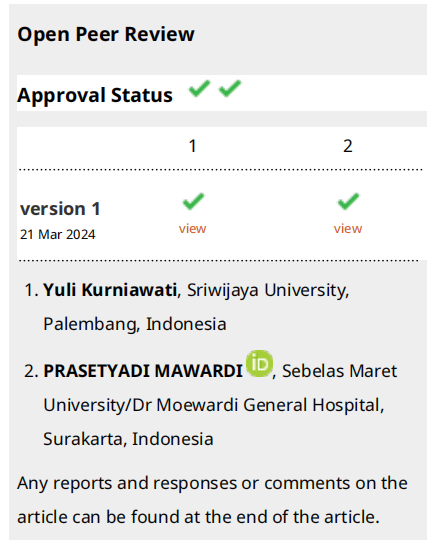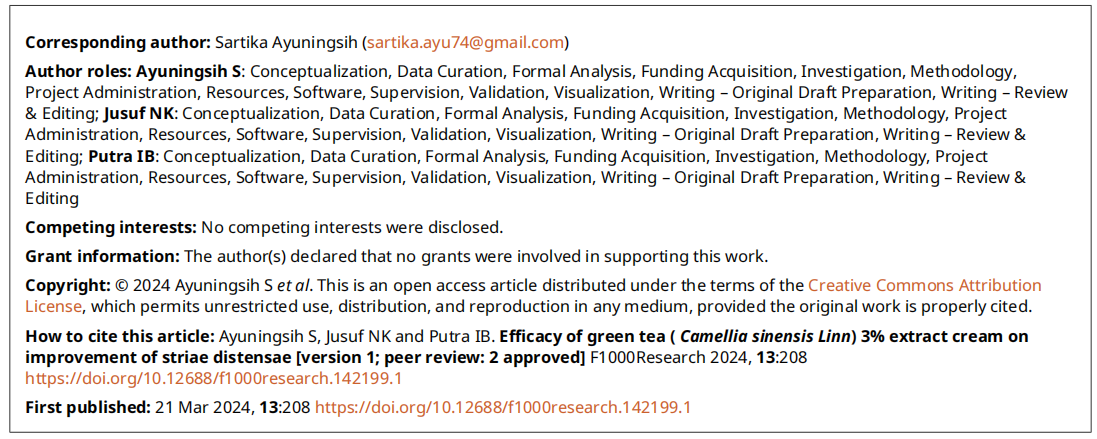文献精选
Pimpa Tantanasrigul1 | Apinya Sripha1 | Bunchai Chongmelaxme21
Department of Medical Services, Ministry of Public Health, Institute of Dermatology, Bangkok, Thailand | 2Department of Social and Administrative Pharmacy, Faculty of Pharmaceutical Sciences, Chulalongkorn University, Bangkok, Thailand
Correspondence: Bunchai Chongmelaxme (该Email地址已收到反垃圾邮件插件保护。要显示它您需要在浏览器中启用JavaScript。)
Received: 5 July 2024 | Accepted: 22 August 2024
Funding: The authors received no specific funding for this work.
Keywords: alpha-arbutin 5% | efficacy | kojic acid 2% | melasma | safety | triple combination cream
ABSTRACT
Background: While the gold standard treatment for melasma is triple combination cream (TCC), arbutin and kojic acid demonstrate their benefits and may be used as an alternative.
Aims: To investigate the efficacy of cream containing alpha-arbutin 5% and kojic acid 2% (AAK) compared with TCC for melasma treatment.
Patients/Methods: A split-faced, randomized study was conducted among 30 participants with melasma, and all were randomized to receive AAK or TCC on each side of their face for 12-week along with 4-week follow-up period. The melanin index (MI), modified Melasma Area Severity Index (mMASI), and physician global assessment (PGA) scores were used to measure the effectiveness of interventions. Recurrence of melasma after treatment discontinuation was evaluated by MI and mMASI. Patient satisfactions and adverse effects were also evaluated. In the analysis, the mean difference (MD) was used for MI and mMASI, while Wilcoxon signed-rank test was for the PGA scores, adverse effects, and patient satisfaction.
Results: The MD of MI and mMASI scores were not different between groups (mMASI [p=0.344] and MI [p=0.268]). The PGA scores only showed improvement on the TCC-treated side (p=0.032). Compared to the AKK group, the subjects with TCC showed higher severity of recurrence (MI [p=0.004] and mMASI [p=0.045]). No difference in patient satisfaction score between the groups, but erythema and stinging were higher in the TCC group.
Conclusions: The AAK cream appeared to be effective for melasma treatment, highlighting a lower recurrent rate and fewer adverse events than standard therapy.
Trial Registration: thaiclinicaltrials.org: TCTR20230124004
This is an open access article under the terms of the Creative Commons Attribution License, which permits use, distribution and reproduction in any medium, provided the original work is properly cited.
© 2024 The Author(s). Journal of Cosmetic Dermatology published by Wiley Periodicals LLC.
Shanshan Zang PhD | Juanjuan Chen MS | Cyril Chevalier MS | Ji Zhang MS | Shumei Li MS | Hequn Wang PhD | Jing Li MS | Yangdong Chen MS | Hongling Xu MS | Le Sheng MS | Zhiming Zhang MS | Jie Qiu PhD
L' Oreal (China) Research and Innovation Center, Shanghai, China
Correspondence
Jie Qiu, L' Oreal (China) Research and Innovation Center, Shanghai, China.
Email: 该Email地址已收到反垃圾邮件插件保护。要显示它您需要在浏览器中启用JavaScript。
Abstract
Objective: To investigate the repairing and anti-wrinkle efficacy of the facial cream enriched with C-xyloside, aiming at comprehensively evaluating its skin anti- aging effect and clarify its potential mechanism of action.
Methods: The repairing efficacy was studied on 3D epidermis skin model and the antiaging efficacy was studied on ex-vivo human skin. Two clinical studies were conducted with Chinese females. In the first study, 49 subjects aged between 30 and 50 with wrinkle concerns were recruited and instructed to apply the investigational cream containing C-xyloside for 8 weeks. Wrinkles attributes were assessed by dermatologist. Instrumental measurements on skin hydration, trans-epidermal water loss (TEWL), and skin elasticity were also conducted. In the second study, 30 subjects aged between 25 and 60 with self-declared sensitive skin and facial redness were recruited and instructed to apply the cream for 4 weeks. Biomarker analysis of the stratum corneum was conducted through facial tape strips.
Results: The cream improved the histomorphology of the 3D epidermis skin model after SLS stimulation, and significantly increase the expression of LOR and FLG. On human skin, the cream improved the histopathology induced by UV, and significantly increased the protein content of COL I and COL III, collagen density and the number of Ki-67 positive cell of skin compared with model group (n= 3, p< 0.01). The results from the first clinical study demonstrate a significant increased the skin hydration and elasticity by 21.90%, 13.08% (R2) and 12.30% (R5), respectively (n= 49, p< 0.05), and the TEWL values decreased by 33.94% (n= 49, p< 0.05), after 8 weeks application of the cream. In addition, the scores for nasolabial folds, glabellar wrinkle, underneath eye wrinkles, crow's feet wrinkle and forehead wrinkle in the volunteers exhibited a significant reduction of 34.02%, 43.34%, 50.03%, 33.64% and 55.81% respectively (n= 49, p< 0.05). The (rCE)/(fCE) ratio of volunteers based on tape stripping significant increased after using the sample cream (n= 30, p< 0.05).
Conclusion: The cream containing C-xyloside showed improvement of skin wrinkles and enhancement of skin barrier function. These efficacies may be attributed to the fact that the sample cream can increase the expression of skin barrier related proteins LOR and FLG, promote the maturation of cornified envelope, enhance collagen I and III protein expression and stimulate skin cell proliferation, to provide sufficient evidence supporting its antiaging efficacy of skin.
KEYWORDS
anti-wrinkle/repairing/antiaging, C-xyloside, in vitro, skin barrier, tape stripping
Shanshan Zang and Juanjuan Chen were authors contributed equally to this work.
This is an open access article under the terms of the Creative Commons Attribution License, which permits use, distribution and reproduction in any medium, provided the original work is properly cited.
© 2024 The Author(s). Journal of Cosmetic Dermatology published by Wiley Periodicals LLC.
Kinga Kazimierska 1 , Ilona Szabłowska-Gadomska 2 , Stefan Rudzi ´nski 2 , Katarzyna Ko´sla 3 , Elzbieta Płuciennik ˙ 4 , Łukasz Bobak 5 , Aleksandra Zambrowicz 5 and Urszula Kalinowska-Lis 1,*
1 Department of Cosmetic Raw Materials Chemistry, Faculty of Pharmacy, Medical University of Lodz, 90-419 Lodz, Poland; 该Email地址已收到反垃圾邮件插件保护。要显示它您需要在浏览器中启用JavaScript。
2 Laboratory for Cell Research and Application, Center for Preclinical Research and Technology, Medical University of Warsaw, Banacha 1b, 02-097 Warsaw, Poland; 该Email地址已收到反垃圾邮件插件保护。要显示它您需要在浏览器中启用JavaScript。 (I.S.-G.); 该Email地址已收到反垃圾邮件插件保护。要显示它您需要在浏览器中启用JavaScript。 (S.R.)
3 Department of Molecular Carcinogenesis, Medical University of Lodz, 90-419 Lodz, Poland; 该Email地址已收到反垃圾邮件插件保护。要显示它您需要在浏览器中启用JavaScript。
4 Department of Functional Genomics, Medical University of Lodz, 90-419 Lodz, Poland; 该Email地址已收到反垃圾邮件插件保护。要显示它您需要在浏览器中启用JavaScript。
5 Department of Functional Food Products Development, Wroclaw University of Environmental and Life Science, 51-640 Wrocław, Poland; 该Email地址已收到反垃圾邮件插件保护。要显示它您需要在浏览器中启用JavaScript。 (Ł.B.); 该Email地址已收到反垃圾邮件插件保护。要显示它您需要在浏览器中启用JavaScript。 (A.Z.) * Correspondence: 该Email地址已收到反垃圾邮件插件保护。要显示它您需要在浏览器中启用JavaScript。
Abstract: Colostrum is gaining popularity in cosmetic products. The present study compared the composition and selected biological properties of colostrum from Polish sheep (colostrum 1) and Swiss sheep (colostrum 2), particularly those that can affect healthy or diseased skin. The antioxidant activity of the colostrums was measured using ABTS and DPPH assays. The effect on the proliferation of human skin fibroblasts, neonatal epidermal keratinocytes, and human diabetic fibroblast (dHF) cells isolated from diabetic foot ulcers was also assayed in vitro by MTT and Presto Blue tests, respectively. The colostrum simulated dHF cell proliferation by up to 115.4%. The highest used concentration of colostrum 1 stimulated normal fibroblast proliferation by 191.2% (24 h) and 222.2% (48 h). Both colostrums inhibited epidermal keratinocyte viability. The influence of the colostrums on the expression of genes related to proliferation (Ki67) and immune response (IL-6, PTGS-2, TSG-6) in dHF cells were compared. Colostrum 1 increased the rate of wound closure (scar test). Analysis of total fat, protein and fatty acid content found the Polish colostrum to be a richer source of fat than the Swiss colostrum, which contained a larger amount of protein. Both colostrums exhibit properties that suggest they could be effective components in cosmetic or medicinal formulations for skin care, especially supporting its regeneration, rejuvenation, and wound healing.
Keywords: antioxidant; cosmetic ingredients; fibroblasts; keratinocytes; gene expression; proliferation; scar test; sheep colostrum; skin diseases
Citation: Kazimierska, K.; Szabłowska-Gadomska, I.; Rudzi ´nski, S.; Ko´sla, K.; Płuciennik, E.; Bobak, Ł.; Zambrowicz, A.; Kalinowska-Lis, U. Biologically Active Sheep Colostrum for Topical Treatment and Skin Care. Int. J. Mol. Sci. 2024, 25, 8091. https:// doi.org/10.3390/ijms25158091 Academic Editors: Elzbieta Budzisz and Paulina Mucha
Received: 2 July 2024
Revised: 18 July 2024
Accepted: 23 July 2024
Published: 25 July 2024
Copyright: © 2024 by the authors. Licensee MDPI, Basel, Switzerland. This article is an open access article distributed under the terms and conditions of the Creative Commons Attribution (CC BY) license (https:// creativecommons.org/licenses/by/ 4.0/).
Sartika Ayuningsih , Nelva Karmila Jusuf , Imam Budi Putra Dermatology and Venereology, University of Sumatera Utara, Medan, North Sumatra, Indonesia
V1 First published: 21 Mar 2024, 13:208 https://doi.org/10.12688/f1000research.142199.1 Latest published: 21 Mar 2024, 13:208 https://doi.org/10.12688/f1000research.142199.1
Abstract
Background
Striae distensae (SD) is a skin condition that frequently causes dermatological consultations and although asymptomatic, it may can cause itch and burning sensation. Green tea extract contains polyphenol, including flavanol, flavandiol, flavonoid, phenolic acid, amino acids and minerals which play a role in the repair of stretch marks through anti-inflammatory mechanism, increase collagen production, fibroblast proliferation, and skin hydration.
Objective
To determine the efficacy of green tea extract cream on striae
Methods
This is a pre-experimental clinical trial with a pretest-posttest design on 36 subjects with striae distensae. Diagnosis establishes through history taking and clinical evaluation. Imam Nelva Alviera (INA) score was used as SD severity before and after the application of the 3% green tea extract cream carried out at weeks 0, 2, 4, 6, and 8. Side effects and subjects’ satisfaction were also recorded. Cochran test was carried out to see the difference before and after treatment, with a pvalue <0.05 considered significant.
Results
Majority of study subjects were 18–25 years (77.8%), had history of pregnancy (75%), had a history of menarche at the age of 12 years (27.8%) and all subjects had striae alba. There was significant decrement in INA score for striae distensae (p<0.001) after eight weeks administration of 3% green tea extract cream. Clinical improvement and no side effects were also noted. All subjects were
Conclusions
The use of 3% green tea extract cream can improve the appearance of
Keywords
striae distensae, stretch mark, INA score, green tea extract, Camellia sinensis linn





![Efficacy of green tea (Camellia sinensis Linn) 3% extract cream on improvement of striae distensae [version 1; peer review: 2 approved]](/ww/media/k2/items/cache/b2da57299c335071295cb3c9ca8d3760_M.jpg)
